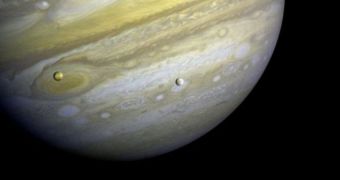Over the years, astronomers have identified a number of celestial bodies in our solar system that may be suitable candidates for holding some forms of life. Jupiter's moon Europe is the clearest example, with the Saturnine moons Titan and Enceladus threading close by. But a new contestant is currently making its way to the top. Experts say that the moon Io, one of Jupiter's largest inner satellites, may have at least contained life in the past. They add that imagining life still exists there to this day is not as far-fetched as it may sound at first, Space reports.
“Everyone right away tends to categorically exclude the possibility of life on Io,” says Washington State University astrobiologist Dirk Schulze-Makuch, who has been studying the moon for quite some time. He explains that the extremely difficult conditions on Io give experts every right to doubt that the moon may hold water or life. But the scientist says that things were not always like this on the Jovian moon, adding that the body must have contained impressive amounts of water when it first appeared, early on in the history of the solar system.
Io really stands out from the crowd of other moons in the solar systems by the fact that it's the most geologically-active one. That is to say, its volcanoes erupt almost around the clock, and its crust is constantly being reshaped. The moon is being severely influenced by the gravitational pull of the gas giant it orbits, which forces the crust on Io to rise or fall be several hundred feet at a time. The space object, which is a little larger than Earth's Moon, can warm up to temperatures of 3,000 degrees F (1,649 degrees Celsius), but the average is -202 degrees F (-130 degrees C).
This means that the largest non-volcanically-active part of the moon is covered with sulfur dioxide, which most likely looks like snowfields. All these stretches of land are being constantly bombarded by radiation from the planet, and astrobiologists believed that this combination of factors made life there impossible. “Life on the surface is all but impossible, but if you go down further into the rocks, it could be intriguing. We shouldn't categorize it as dead right away just because it's so extreme. There must have been quite a lot of water on Io shortly after formation, judging from the amount of water ice on Europa and Ganymede,” Schulze-Makuch explains.

 14 DAY TRIAL //
14 DAY TRIAL //